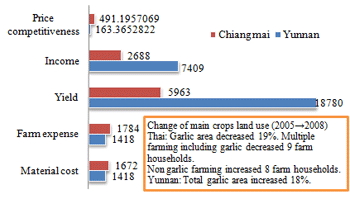Impact Analyses of Economic Integration on Agriculture and Policy Proposals toward Poverty Alleviation in the Greater Mekong Sub-region
Description
We have conducted comparative case studies on the impacts of economic integration on agriculture in three (3) representative border sites in the least developed regions of the Greater Mekong Sub-region (GMS) and placed emphasis on the diversification of farmers’ incomes and job opportunities through crop diversification, high value-added products, production-market linkages as well as policy measures with positive implications valuable for the alleviation of negative impacts.
The GMS covering Thailand, Lao PDR, Vietnam, Myanmar and Southern China (Yunnan) and the international river, Mekong River, has recently shown significant changes in trade structure due to the development of new infrastructures (e.g. trans-boundary transportation systems, deregulation and facilitation of border trade systems) and trade liberalization (lowering and removing tariffs in ASEAN-AFTA and ASEAN-China FTA).
Between northeastern Thailand and northern Lao PDR (Case 1): Lao farmers had produced feed corn with considerably lower production cost than Thai farmers due to less material inputs. The Thai feed industry has shifted the contract farming operations of feed corn to the Laotian regions and has exported the products back to Thailand. On the other hand, Thai farmers have shifted their crop production from feed corn to more profitable resource crops such as Para rubber, sugarcane and cassava (Table1).
Between northern Thailand and southern China (Yunnan) (Case 2): Due to the high cost of agricultural management and very much lower yield in Thailand, Yunnan has the higher price competitiveness. Northern Thai farmers have been forced to shift from garlic to other crops which have less competition from China. But, some farmers have failed to convert their crops and have fallen in considerable income reduction (Figure2).
Between southern China (Yunnan) and northern Lao PDR (Case 3): Yunnan farmers have very limited owned farm land resources, so the number of border farmers going over to the Laotian area and growing more crops there has tripled in 2008 as compared from the previous year, and Chinese migrants has increased one and a half times. Moreover, Chinese companies increased their contract farming for sugarcane and Para rubber at Laotian areas and promoted crop production by Laotian farmers, Lao people’s employment opportunity, and finally more opportunity for household income.
Our comparative case studies revealed that each country took policy measures to promote the production of comparatively advantageous crops on one hand; but, on the other hand, took countermeasures to support their own farmers to sustain and/or convert comparatively disadvantageous crops to limit the negative effects and strengthen non-tariff barriers. The Thai government implemented alleviation measures for garlic and feed corn but with very limited effects. The Thai government and Chinese local governments have strengthened their plant quarantine inspection practices toward imported products resulting in some conflicts. Our study also implies that it would be very important to emphasize a concept of ‘regional cooperation’ more in the framework of ASEAN-China FTA and other FTAs and that every country’s experiences should bring benefit to the development of regional agreements on technical and financial support for crop diversification, harmonization of non-tariff barriers, export and production promotion measures based on regional consensus.
Figure, table
-
Fig. 1. GMS and Research sites
Note: GMS (The Greater Mekong Sub-region) comprises Thailand, Cambodia, Vietnam, Laos, Myanmar and China (Yunnan). -
Table 1 Comparison of maize cost between Laos and Thailand
-
Fig. 2 Comparison of garlic cost of Northern Thai and Yunnan, China (Units: Yield:kg/ha,Material cost・Farm expense・Income:US$/ha)
Notes: Sample number of farm households, Northern Thai:45, Yunnan:116 Price competitiveness= cost/tonne(US$/t) -
Table 2 Issues, policy measures and possible policy directions to cope with them
- Affiliation
-
Development Research Division
- Classification
-
Research
- Term of research
-
FY2006~2009
- Responsible researcher
-
CHIEN Hsiaoping ( Development Research Division )
MIYATA Satoru ( Development Research Division )
ANDO Masuo ( Development Research Division )
KANG Yunhai ( Institute of Social Sciences, Yunnan Province, China )
SUPHANCHAIMAT Nongluck ( Khon Kaen University )
SUEBPONGSANG Pornsiri ( Chiang Mai University )
VONGXAY Khonesavanh ( Ministry of Agriculture and Forestry, Lao PDR )
- ほか
- Publication, etc.
-
IRCAS Working Report No.69 (2010)
- Japanese PDF




